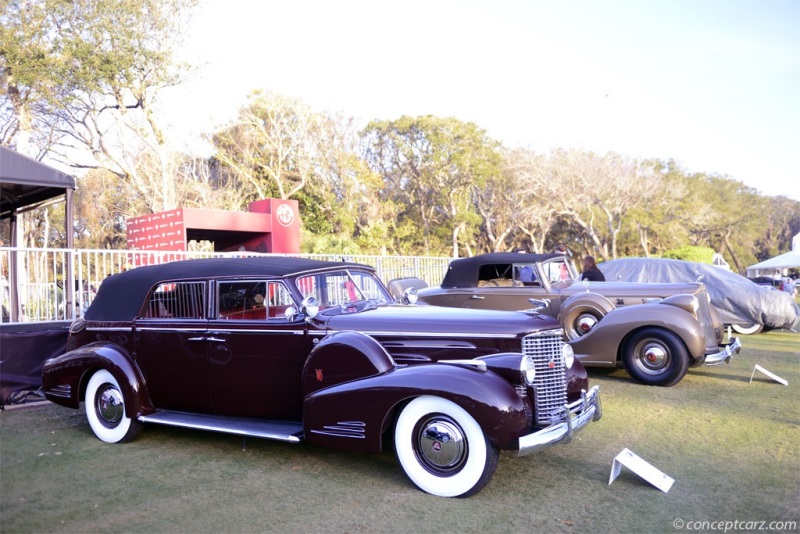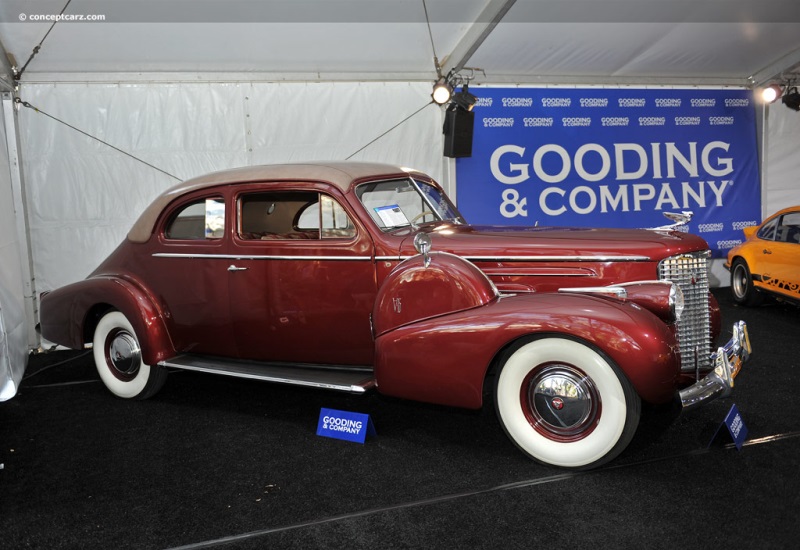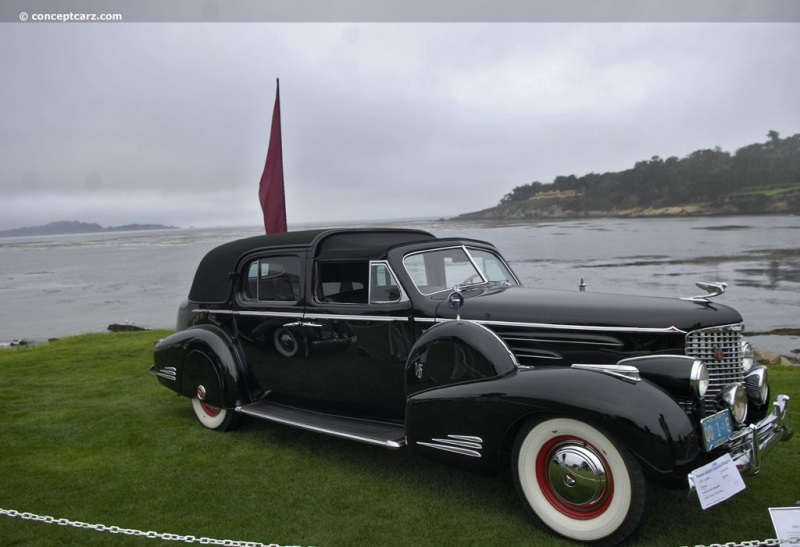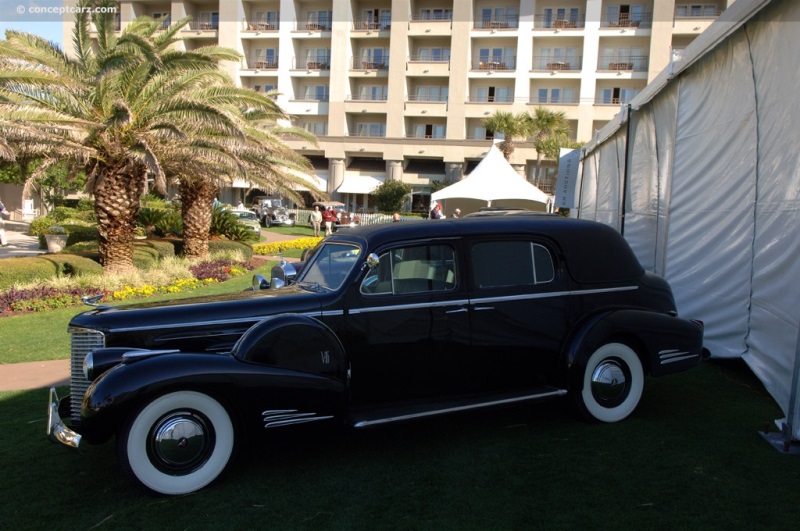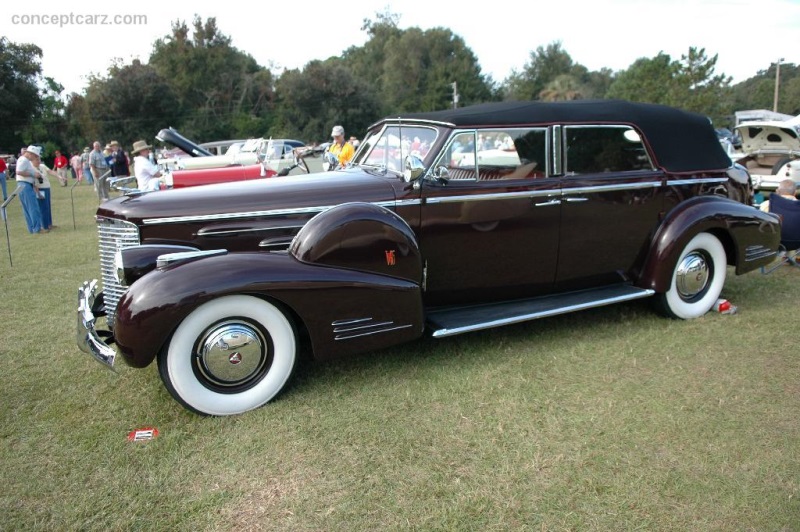Sales of the custom-ordered coach-built automobile continued to decline during the 1930s, as were the grand, multi-cylinder engines that powered the greatest era of American automobile production. Cadillac had been the first to introduce a production V16-powered model in the United States, announced just prior to the stock market crash of 1929. The new V-16 Series 452 was displayed at New York City's automobile show on January 4th of 1930. The overhead-valve, 452 cubic-inch V-16 engine had a narrow 45-degree V-angle and was backed by a three-speed synchromesh manual gearbox.
Marmon followed Cadillac's introduction with a V-16 engine of their own, and magnificent cars were followed by Duesenberg, Stutz, and Packard (and others). Long wheelbases and engines that were far and above the average six-cylinder were the hallmarks of this wonderful era.
Sales of the V-16 Cadillac peaked in mid-1930, with production falling precipitously. Minimal production followed the V-16 throughout the remainder of the decade with just 50 examples built in both 1935 and 1937. 1940 was only slightly better with 51 examples constructed.
The 1933 Cadillac V-16, known as the model 452C, wore a new design with Fisher no draft individually controlled ventilation, skirted fenders, spinner hubcaps, a vee-shaped radiator shell and grille, and a new winged goddess mascot. As before, the list of body styles was extensive, with approximately 70 styles filling the catalog. The styling was further refined in 1934 on the 452D and the 452E in 1935. By this point in history, the V-16 wore the Fisher Turret Top all-steel roof, but the bodies continued to be built by Fleetwood.
In 1936, it was redesigned as Series 90 as Cadillac reorganized its model names. Hydraulic brakes were added a year later, the final year for these 452 and Series 90 V-16 Cadillacs.
Second Generation V-16
Cadillac shortened the wheelbase of the V-16 by 13 inches for 1938, now measuring 141 inches, and shared with the V-12 Series 70 and 75. Despite the smaller footprint, the bodies were equal or larger in all dimensions than the previous bodies due to the reconfigured sixteen-cylinder engine. The new L-head engine was nearly flat and positioned low in the frame and installed partially behind the line of the firewall. The short bore and stroke were identical, at 3.25 inches, and featured a wider 135-degree V-angle. It had a nine main bearing crankshaft - four more than the previous OHV V16 - twin distributors, twin fuel pumps, twin water pumps, and twin carburetors. The whisper-quiet engine delivered 185 smooth horsepower and continued to use a three-speed selective synchromesh transmission with a single disc clutch and column shift controls. With the fuel pumps being interconnected, either could supply both carburetors if required.
Although sharing many similarities with its V-12 siblings, the V16 models differed from the firewall forward. The interior instrument panels were the same as those in the V-8 cars and changed yearly with the V-8 models from 1938 to 1940. Only the 1938 V-16 models had 'Sixteen' in art deco script on the horn button, as the 1939 and 1940 models had the Cadillac crest on the button, just like the V-8.
Production continued to be exclusive, with 315 sold in 1938, 1938 examples in 1939, and approximately 61 (as few as twenty) before production ended in December of 1939. The sixteen-cylinder Cadillac had outlived the twelve which had ended production following the 1937 season. Cadillac vehicles for the next four (plus) decades would solely rely on eight-cylinder power.
Before the V-16 model production came to a close, updates were made to the bumper, taillights, and instrument panel. The factory directional signals and sealed beam headlights were also new features. The wheelbase continued to measure 141 inches, and the overall length was 255 inches. Nearly all the V-16s built in 1940 were semi-customs, with the exception of a handful of one-off coachbuilt models. A dozen body styles were listed in the factory catalog, most with seating for five or seven passengers, with prices that eclipsed $5,000. The two-door coupe was priced at $5,340 and the five-passenger version at $5,440. The convertible coupe also listed at $5,440. The Sedan was priced at $5,140, the five-passenger Imperial Sedan at $5,215, and the seven-passenger version at $5,420. The Town Sedan listed for $5,700 and the Formal Sedan with seating for seven at $6,055. The most expensive was the Town Car at $7,175.
During the Cadillac V-16's eleven-year production, 4,076 examples were built. Approximately 514 examples were equipped with the short stroke, L-head, wide-angle, 431 CID V8 with 185 horsepower.
by Daniel Vaughan | Mar 2021
Marmon followed Cadillac's introduction with a V-16 engine of their own, and magnificent cars were followed by Duesenberg, Stutz, and Packard (and others). Long wheelbases and engines that were far and above the average six-cylinder were the hallmarks of this wonderful era.
Sales of the V-16 Cadillac peaked in mid-1930, with production falling precipitously. Minimal production followed the V-16 throughout the remainder of the decade with just 50 examples built in both 1935 and 1937. 1940 was only slightly better with 51 examples constructed.
The 1933 Cadillac V-16, known as the model 452C, wore a new design with Fisher no draft individually controlled ventilation, skirted fenders, spinner hubcaps, a vee-shaped radiator shell and grille, and a new winged goddess mascot. As before, the list of body styles was extensive, with approximately 70 styles filling the catalog. The styling was further refined in 1934 on the 452D and the 452E in 1935. By this point in history, the V-16 wore the Fisher Turret Top all-steel roof, but the bodies continued to be built by Fleetwood.
In 1936, it was redesigned as Series 90 as Cadillac reorganized its model names. Hydraulic brakes were added a year later, the final year for these 452 and Series 90 V-16 Cadillacs.
Second Generation V-16
Cadillac shortened the wheelbase of the V-16 by 13 inches for 1938, now measuring 141 inches, and shared with the V-12 Series 70 and 75. Despite the smaller footprint, the bodies were equal or larger in all dimensions than the previous bodies due to the reconfigured sixteen-cylinder engine. The new L-head engine was nearly flat and positioned low in the frame and installed partially behind the line of the firewall. The short bore and stroke were identical, at 3.25 inches, and featured a wider 135-degree V-angle. It had a nine main bearing crankshaft - four more than the previous OHV V16 - twin distributors, twin fuel pumps, twin water pumps, and twin carburetors. The whisper-quiet engine delivered 185 smooth horsepower and continued to use a three-speed selective synchromesh transmission with a single disc clutch and column shift controls. With the fuel pumps being interconnected, either could supply both carburetors if required.
Although sharing many similarities with its V-12 siblings, the V16 models differed from the firewall forward. The interior instrument panels were the same as those in the V-8 cars and changed yearly with the V-8 models from 1938 to 1940. Only the 1938 V-16 models had 'Sixteen' in art deco script on the horn button, as the 1939 and 1940 models had the Cadillac crest on the button, just like the V-8.
Production continued to be exclusive, with 315 sold in 1938, 1938 examples in 1939, and approximately 61 (as few as twenty) before production ended in December of 1939. The sixteen-cylinder Cadillac had outlived the twelve which had ended production following the 1937 season. Cadillac vehicles for the next four (plus) decades would solely rely on eight-cylinder power.
Before the V-16 model production came to a close, updates were made to the bumper, taillights, and instrument panel. The factory directional signals and sealed beam headlights were also new features. The wheelbase continued to measure 141 inches, and the overall length was 255 inches. Nearly all the V-16s built in 1940 were semi-customs, with the exception of a handful of one-off coachbuilt models. A dozen body styles were listed in the factory catalog, most with seating for five or seven passengers, with prices that eclipsed $5,000. The two-door coupe was priced at $5,340 and the five-passenger version at $5,440. The convertible coupe also listed at $5,440. The Sedan was priced at $5,140, the five-passenger Imperial Sedan at $5,215, and the seven-passenger version at $5,420. The Town Sedan listed for $5,700 and the Formal Sedan with seating for seven at $6,055. The most expensive was the Town Car at $7,175.
During the Cadillac V-16's eleven-year production, 4,076 examples were built. Approximately 514 examples were equipped with the short stroke, L-head, wide-angle, 431 CID V8 with 185 horsepower.
by Daniel Vaughan | Mar 2021
Related Reading : Cadillac Series 90 History
From 1930 through 1940 Cadillac produced a monsterous sixteen-cylinder engine. It was first displayed to the automotive community at the Detroit Opera House prior to the Detroit Auto Show. This was the largest number of cylinders to power an automobile of all time. The hood that housed the engine was intimidating, larger and longer than any other vehicle. Up to this point, there were only a few manufacturers....
Continue Reading >>
Continue Reading >>
Similarly Priced Vehicles
Cadillac Monthly Sales Volume
March 2023
36,321
1940 Cadillac Series 90 Sixteen Vehicle Profiles
Recent Vehicle Additions
Performance and Specification Comparison
Price Comparison
$1,685 - $2,195
$2,095 - $3,825
$2,670 - $3,695
$3,000 - $5,120
Series 90 Specification Comparison by Year
Year
Production
Wheelbase
Engine
Prices
Related Automotive News

1932 Duesenberg J Figoni Sports Torpedo Named Best of Show at the 71st Pebble Beach Concours d'Elegance
2022 Charitable Donations Surpass %242.67 Million
A unique Duesenberg reprised its early role as Concours winner by taking the top prize at the Pebble Beach Concours dElegance.
This year, 40 classic cars from 18 countries and 33 states pulled...

Alfa Romeo Named Best of Show at the 68th Pebble Beach Concours d'Elegance
Touring-Bodied Alfa Romeo 8C 2900B Named Best of Show at the 68th Pebble Beach Concours dElegance
PEBBLE BEACH, Calif. (August 26, 2018) — After an intense competition that drew diverse cars from around the globe, the coveted gold Best of Show...

2015 Pebble Beach Concours d'Elegance Best of Show
PEBBLE BEACH, Calif. (August 17, 2015) -- An Italian Isotta Fraschini Tipo 8A Cabriolet that once turned heads and garnered top prizes in the classic era glided to victory at the 65th Pebble Beach Concours dElegance on Sunday.
The competition...

Shelby Heritage Display Features Rarest of the Rare at Rolex Monterey Motorsports Reunion
Complementing the impressive number of authentic competition Shelby Cobras thundering around the circuit in their dedicated race group (3A) at this years Rolex Monterey Motorsports Reunion, August 17-19, will be a collection of unequalled magnitude...

Carroll Shelby, Ford Family for More Than Half a Century
Carroll Shelby was a member of the Ford family for the better part of 60 years, producing stunning performance vehicles from concepts to production models.
He once said his energy and passion for performance products were always strongest when he was...
























